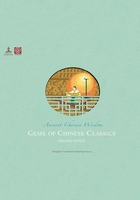
周易 (zhōu yì)
Book of Changes
Text that defines yin and yang
Zhouyi, also known as the “I Ching” or the “Book of Changes,” is undisputedly the true root of Chinese culture. Created more than 5,000 years ago, the classic text contains not only a sophisticated divination system, but also the key philosophical concept of yin and yang.
Therefore, in the past five millennia, Chinese people have frequently used the book as an aid to make decisions, predict the future and as a popular source of wisdom and inspiration.
Many people believe that the principles of the book were created by Fuxi, a figure in Chinese mythology who was the elder brother of Nuwa, who created humans and mended the sky at the dawn of history.
It was said that one day, Fuxi saw a chimera with the head of a dragon and the body of a horse emerging from a large cave. He was fascinated by the unusual arrangement of markings on its body. Inspired by the chimerical pattern, he created the famous Eight Trigrams.
A number of historians and scholars are convinced that the book was first named just Yi, a word derived from a type of lizard in Chinese. Ancient Chinese believed it was a kind of chameleon which changed its color quickly according to its background, impling “easy to change” or “changeable.”
It was not until the King Wen (1152-1056 BC) of Zhou rewrote the original Yi and later Confucius (551-479 BC) added commentaries to it, the book became commonly known as Zhouyi.
And some scholars claim that Confucius’ commentaries helped to transform Yi from a divination text into a philosophical masterpiece.
What King Wen of Zhou did was defining the fundamental concept of the divination system, namely, yin and yang, and he also pointed out that the two elements should always be valued in terms of their nature and status.
To illustrate the basic concept and the interaction and interchange of the two aspects of all things, the book used the Eight Trigrams and 64 sets of six-line hexagrams to represent and interpret the “changes.”

Each hexagram is comprised of six stacked horizontal lines, with a solid line representing yang and a broken line or a line with a gap in the middle representing yin.
By taking into consideration of four different statuses of both yin and yang, the 64 hexagrams can then be arranged into as many as 4,096 different combinations.
When yang was at the top, yin could be increasing at the bottom and eventually yin would rise to the top as yang went to the bottom. And the process would never stop, therefore Chinese believe that nothing is permanent in the world except change.
At the beginning, Chinese scholars and politicians used Zhouyi for divination, but later it was applied in almost all fields, including astronomy, geography, military, sciences, literature, music, agriculture and business.
The concepts of yin and yang and constant changes are closely associated with religions, such as Buddhism and Taoism in China.
Both Buddhist expressions of life and death and reincarnation and the Taoist symbol of Taijitu, which is a diagram known as the Supreme Ultimate, reflect the omnipresent duality of all things in the universe.
Even late Chinese leader Mao Zedong, a Marxist and revolutionary, expressed many ideas and concepts in his theory of dialectical materialism similar to the principles of Zhouyi.
Mao said in “On the Correct Handling of Contradictions Among the People” (1957), one of his most important philosophical essays, that under certain conditions, bad things may lead to good results and good things may lead to bad results.
Today, many scholars and historians across the world are still trying to understand the profound and unparalleled role Zhouyi has played and, very likely, will continue to play in the development of the Chinese civilization in the coming millennia.